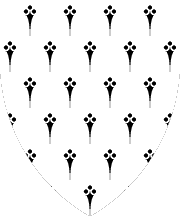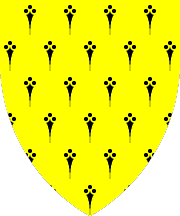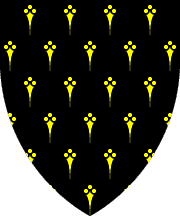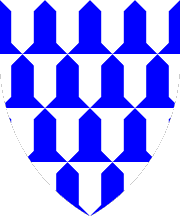Furs: Difference between revisions
No edit summary |
No edit summary |
||
| (14 intermediate revisions by the same user not shown) | |||
| Line 1: | Line 1: | ||
{{BoilerplateHeader}} | |||
''See also'' [[Ermined Tinctures]], [[Tincture]]. | ''See also'' [[Ermined Tinctures]], [[Tincture]]. | ||
| Line 36: | Line 36: | ||
|| http://mistholme.com/wp-content/uploads/2015/02/papellony2-258x300.jpg | || http://mistholme.com/wp-content/uploads/2015/02/papellony2-258x300.jpg | ||
|| http://mistholme.com/wp-content/uploads/2015/03/plumetty-263x300.jpg | || http://mistholme.com/wp-content/uploads/2015/03/plumetty-263x300.jpg | ||
|| [[File:Scaly-262x300.jpg]] | |||
|- | |- | ||
|| Papellony (field treatment) (Period) | || Papellony (field treatment) (Period) | ||
|| Papellony (fur) (Accepted) | || Papellony (fur) (Accepted) | ||
|| Plumetty (Period) | || Plumetty (Period) | ||
|| Scaly (field treatment, not a fur) | |||
|} | |} | ||
''Images from Mistholme used by permission.'' | |||
===Vector Graphics:=== | |||
* [[Book of Traceable Heraldic Art]] | |||
* Viking Answer Lady - http://www.vikinganswerlady.com/Stars/Heraldry_SVG_Images/index.htm | |||
** http://www.vikinganswerlady.com/Stars/Heraldry_SVG_Images/Ermine_Spots.htm (lots of wild ermine spots) | |||
===[[Pennsic Traceable Art Project]]:=== | ===[[Pennsic Traceable Art Project]]:=== | ||
| Line 52: | Line 61: | ||
'''Furs''' | '''Furs''' | ||
There are several tinctures that are actually stylized patterns, classified as ''furs''. These include: | There are several tinctures that are actually stylized patterns, classified as ''furs''. These include: | ||
{| | {| class=wikitable | ||
| | | ''Ermine'' - argent with "tails" [originally from an ermine's hide] sable || ''Counter-ermine'' (sometimes called ''Ermines'') sable with "tails" argent || ''Erminois'' - Or with "tails" sable || ''Pean'' sable with "tails" Or | ||
|- | |- | ||
| | | [[File:Ermine.gif]] | ||
|| [[File:Ermines.gif]] | |||
|| [[File:Erminois.gif]] | |||
|| [[File:Pean.gif]] | |||
|- | |- | ||
| | | ''Vair'' - interlocking "bells" [originally squirrel hides] alternately argent and azure) || ''Potent'' - interlocking "T's" alternately argent and azure | ||
|| | |- | ||
| [[File:Vair.gif]] | |||
| [[File:Potent.gif]] || || | |||
|} | |} | ||
===Some Fur Variants=== | |||
by Gotfrid von Schwaben at Modar University - <nowiki>http://www.modaruniversity.org/furs.gif</nowiki> | |||
<p> | |||
http://www.modaruniversity.org/furs.gif | |||
=Sources:= | =Sources:= | ||
* Academy of St. Gabriel "Medieval Heraldry Archive" - http://www.s-gabriel.org/heraldry/ | * Academy of St. Gabriel "Medieval Heraldry Archive" - http://www.s-gabriel.org/heraldry/ | ||
* Archive of St. Gabriel reports - | * Archive of St. Gabriel reports - http://www.panix.com/~gabriel/public-bin/archive.cgi | ||
* Laurel Armory Articles - http://heraldry.sca.org/laurel/armory_articles.html | * Laurel Armory Articles - http://heraldry.sca.org/laurel/armory_articles.html | ||
| Line 76: | Line 93: | ||
* Parker's Heraldry - http://karlwilcox.com/parker/ | * Parker's Heraldry - http://karlwilcox.com/parker/ | ||
* Riestap's ''Armorial Général - //http:''www.euraldic.com/lasu/bl/bl_a_aa.html | * Riestap's ''Armorial Général - //http:''www.euraldic.com/lasu/bl/bl_a_aa.html | ||
=Precedents:= | =Precedents:= | ||
| Line 85: | Line 101: | ||
==Definition:== | ==Definition:== | ||
''(includes defaults, proper tinctures, blazoning)'' | ''(includes defaults, proper tinctures, blazoning)'' | ||
===August 2005 | ===August 2005 - plumetty is a form of vair:=== | ||
Given Woodward's suggestion that the plumetty field is a form of vair; and given the wide variation in the depiction of vair in period, along with the fact that the internal markings of plumetty are worth no more than diapering we unfortunately must conclude that vair and plumetty are too similar for a CD. They lack the significant change in field partition required by RfS X.4.a for a CD. [Ilona von Neunhoff, | Given Woodward's suggestion that the plumetty field is a form of vair; and given the wide variation in the depiction of vair in period, along with the fact that the internal markings of plumetty are worth no more than diapering we unfortunately must conclude that vair and plumetty are too similar for a CD. They lack the significant change in field partition required by RfS X.4.a for a CD. [Ilona von Neunhoff, [http://heraldry.sca.org/loar/2005/08/05-08lar.html 08/05], R-Atenveldt] | ||
* http://heraldry.sca.org/precedents/elisabeth/armory.html | |||
===August 2002 - scaly vs papellony=== | |||
[a sinister gore papellony Or and purpure] The gore was originally blazoned as scaly. Scaly is defined in the Pictorial Dictionary as "a field treatment, consisting of many semi-circles or lunes, covering the field." The overall effect of scaly is of thick lines on a background, as in the field treatment masoned (but with the panes of a different shape than in masoned.) | [a sinister gore papellony Or and purpure] The gore was originally blazoned as scaly. Scaly is defined in the Pictorial Dictionary as "a field treatment, consisting of many semi-circles or lunes, covering the field." The overall effect of scaly is of thick lines on a background, as in the field treatment masoned (but with the panes of a different shape than in masoned.) | ||
This gore is tinctured in a form of papellony, which is also defined in the Pictorial Dictionary. Papellony has two forms. One form looks much like scaly, functions as a field treatment, and is blazoned as [background tincture] papellony [treatment tincture]. The other form of papellony is a field division and is blazoned | This gore is tinctured in a form of papellony, which is also defined in the Pictorial Dictionary. Papellony has two forms. One form looks much like scaly, functions as a field treatment, and is blazoned as [background tincture] papellony [treatment tincture]. The other form of papellony is a field division and is blazoned as papellony [tincture x] and [tincture y]. The second form is the form found in this submission. It is drawn using solid panes of alternating tinctures, as in the field lozengy, but with the panes shaped like solid scales, rather than like the lozenges in lozengy. See the Pictorial Dictionary for more discussion. [Ailionóra inghean uí Mhurchadha, [http://sca.org/heraldry/loar/2002/08/02-08lar.html 08/2002], A-Calontir] | ||
* http://heraldry.sca.org/precedents/francois/wreath.html#FIELDTMisc | |||
===September 1997 - vairy of 3 tinctures or more=== | |||
[registering vairy of three tinctures] Gerard Leigh (a 16th century herald) mentions very rare occurrences of vairy of three or more tinctures. This particular form of vairy was listed in the examples of vair, described by Fox-Davies as "vairy of four tinctures". Papworth has Vairy Or, gules and azure., Sir. Roger Holthouse, from Glover's Ordinary. As a treatment found in both a period treatise and actual period armory we have no qualms about registering this. (Diego Miguel de Vega, 9/97 p. 10) | [registering vairy of three tinctures] Gerard Leigh (a 16th century herald) mentions very rare occurrences of vairy of three or more tinctures. This particular form of vairy was listed in the examples of vair, described by Fox-Davies as "vairy of four tinctures". Papworth has Vairy Or, gules and azure., Sir. Roger Holthouse, from Glover's Ordinary. As a treatment found in both a period treatise and actual period armory we have no qualms about registering this. (Diego Miguel de Vega, 9/97 p. 10) | ||
*http://heraldry.sca.org/precedents/jaeprec.html#Vairy | |||
===September 1993 - Vair: the continuing saga=== | |||
It was announced in the cover letter of the July 93 LoAR that vair is vair, whether drawn in an earlier, undulating style or in a late-period, angular form; the difference is purely artistic, and shouldn't even merit mention in the blazon. This has raised a question from some commenters as to which varieties of vair we should blazon, and why. | It was announced in the cover letter of the July 93 LoAR that vair is vair, whether drawn in an earlier, undulating style or in a late-period, angular form; the difference is purely artistic, and shouldn't even merit mention in the blazon. This has raised a question from some commenters as to which varieties of vair we should blazon, and why. | ||
Well, there are certainly some varieties of vair we've never blazoned: vair en pal, for instance, is a valid period rendition of plain vair that acquired its own name only in the 19th Century. That example provides us with the key: we should recognize only those varieties of vair that period heralds recognized. That excludes, e.g., vair en pal, vair ancient, and the German Gespaltenesfeh. Other varietal forms, however, were making their appearance toward the end of period; they should be acceptable, both as motifs and in blazon. | *Well, there are certainly some varieties of vair we've never blazoned: '''vair en pal''', for instance, is a valid period rendition of plain vair that acquired its own name only in the 19th Century. That example provides us with the key: we should recognize only those varieties of vair that period heralds recognized. That excludes, e.g., vair en pal, vair ancient, and the German Gespaltenesfeh. Other varietal forms, however, were making their appearance toward the end of period; they should be acceptable, both as motifs and in blazon. | ||
The first vair-variant seems to have been potent. Legh's Accidens of Armorie gives an illustration of a potent field, which he blazons meirre or varry cuppe, and attributes to the Spanish; Guillim's Display of Heraldrie follows Legh in this, but prefers the blazon potent counter-potent. Both the fur and the blazon are acceptable, then; and indeed, Guillim's illustration shows a field potent en point, which might give us some justification for the same arrangement applied to vair. | *The first vair-variant seems to have been '''potent'''. Legh's ''Accidens of Armorie'' gives an illustration of a potent field, which he blazons meirre or varry cuppe, and attributes to the Spanish; Guillim's ''Display of Heraldrie'' follows Legh in this, but prefers the blazon potent counter-potent. Both the fur and the blazon are acceptable, then; and indeed, Guillim's illustration shows a field potent en point, which might give us some justification for the same arrangement applied to vair. | ||
Vair en point makes an appearance in its own right, however, along with counter-vair. Both of these appear to be German variants; Leonhard's Grosse Buch der Wappenkunst blazons them as Wechselfeh "back-and-forth vair" and Sturzgegenfeh "falling-reversed vair", respectively. They first showed up in the early 17th Century, and managed to find actual use in French armory soon afterward: Baron's l'Art Heraldique cites the arms of Brotin, Contrevairé d'or et de gueules, and of Durant, Vair en pointe. We can consider them to have been used, and recognized by heralds, within our "grey area" of documentation -- if not explicitly from within period, then at the very least compatible with Society practice. | *'''Vair en point''' makes an appearance in its own right, however, along with '''counter-vair'''. Both of these appear to be German variants; Leonhard's ''Grosse Buch der Wappenkunst'' blazons them as Wechselfeh "back-and-forth vair" and Sturzgegenfeh "falling-reversed vair", respectively. They first showed up in the early 17th Century, and managed to find actual use in French armory soon afterward: Baron's ''l'Art Heraldique'' cites the arms of Brotin, Contrevairé d'or et de gueules, and of Durant, Vair en pointe. We can consider them to have been used, and recognized by heralds, within our "grey area" of documentation -- if not explicitly from within period, then at the very least compatible with Society practice. | ||
It is equally illuminating to observe the styles of vair that period heralds did not distinguish. Foster's Dictionary of Heraldry shows many artistic variations taken from period rolls: they range from the wavy "vair ancient" style to the tesselated "modern vair" -- with a broad spectrum in between. See the arms of Bruis, p.33, and of Marmion, p.137, for different artists' versions of the same armory: the stylizations of vair include one that resembles nipples, and another that could be reblazoned barry embattled. Sometimes, the same roll of arms will employ two different styles of vair: Siebmacher's Wappenbuch of 1605, for instance, gives examples of "modern vair" (in the arms of von Pappenheim, p.19) and "vair ancient" (in the arms of von Linsingen, p.182). A similar example, with several different styles of vair ("ancient", "modern", and "other") used in a single roll of arms c.1500, may be seen in Pastoreau's Traité d'Héraldique, p.293. | *It is equally illuminating to observe the styles of vair that period heralds did not distinguish. Foster's ''Dictionary of Heraldry'' shows many artistic variations taken from period rolls: they range from the wavy "vair ancient" style to the tesselated "modern vair" -- with a broad spectrum in between. See the arms of Bruis, p.33, and of Marmion, p.137, for different artists' versions of the same armory: the stylizations of vair include one that resembles nipples, and another that could be reblazoned barry embattled. Sometimes, the same roll of arms will employ two different styles of vair: Siebmacher's ''Wappenbuch'' of 1605, for instance, gives examples of "modern vair" (in the arms of von Pappenheim, p.19) and "vair ancient" (in the arms of von Linsingen, p.182). A similar example, with several different styles of vair ("ancient", "modern", and "other") used in a single roll of arms c.1500, may be seen in Pastoreau's ''Traité d'Héraldique'', p.293. | ||
Some commenters have argued that the distinction between vair ancient and the more angular modern vair, though certainly worth no heraldic difference, should nonetheless be blazoned as a courtesy to the submitters -- just as we blazon shamrock vs. trefoil, or sword vs. scimitar. The latter terms, however, are all found in period; vair | *Some commenters have argued that the distinction between '''vair ancient''' and the more angular '''modern vair''', though certainly worth no heraldic difference, should nonetheless be blazoned as a courtesy to the submitters -- just as we blazon shamrock vs. trefoil, or sword vs. scimitar. The latter terms, however, are all found in period; vair ancient is not, to the best of my knowledge (not even to the extent of being described in an heraldic tract as "vair as it was drawn in ancient times"). Given the absence of "vair ancient" from period blazons, given the equally varied styles of vair that weren't blazoned, and given the absurdity of a medievalist re-creation group having to specify "drawn in the medieval style" in a blazon (as silly as blazoning a lion drawn in the medieval style, not the modern naturalistic style), I find the tone of moral indignation in some of the recent commentary to be unjustified. Vair ancient should not be explicitly blazoned in the SCA if it was not so blazoned in period; it is exactly the sort of artistic detail that should be left to the artist. | ||
http://heraldry.sca.org/loar/1993/09/cvr.html | |||
===March 1981 - papelonny diapering vs fur=== | |||
Papelonny of one tincture is a form of diapering. Papelonny of two tinctures is an allowed fur. WVS [38] [LoAR 10 Mar 81], p. 9. | Papelonny of one tincture is a form of diapering. Papelonny of two tinctures is an allowed fur. WVS [38] [LoAR 10 Mar 81], p. 9. | ||
*http://heraldry.sca.org/precedents/wilhelm/dtoi.html | |||
===November 1978 - plumetty a form of vair=== | |||
The article on heraldry in the 11th edition of the Encyclopedia Britannica, by Oswald Barron, states that there is a single British example of "Plumetty." ... A fifteenth-century book of arms gives it, blazoned "Plumetty of gold and purple," for Mydlam in Coverdale ... This form is acceptable for S.C.A. use. It should be treated as a form of vair, being composed of any metal with any color, but not two metals or two colors. Whichever tincture falls in the uppermost row should be mentioned first; blazoned in the standard form, Mydlam is "Plummetty or and purpure." (KFW, 15 Now 78 [22], p. 1) | The article on heraldry in the 11th edition of the Encyclopedia Britannica, by Oswald Barron, states that there is a single British example of "Plumetty." ... A fifteenth-century book of arms gives it, blazoned "Plumetty of gold and purple," for Mydlam in Coverdale ... This form is acceptable for S.C.A. use. It should be treated as a form of vair, being composed of any metal with any color, but not two metals or two colors. Whichever tincture falls in the uppermost row should be mentioned first; blazoned in the standard form, Mydlam is "Plummetty or and purpure." (KFW, 15 Now 78 [22], p. 1) | ||
*http://heraldry.sca.org/precedents/karina/karinacombined.html#plumetty | |||
== | ==Registerability:== | ||
(Restricted, Reserved, SFPP, OOP)</span> | |||
===April 1994 - unregisterable form of plumetty=== | |||
[Returning Plumetty argent and vert, a sledgehammer and overall a single horned anvil reversed sable.] The plumetty field treatment here [the pieces being long, vertical shafts with the tips in chief and curled over; similar to an illustration in Friar's A Dictionary of Heraldry, p.159] does not appear to be a valid period variant. [4/94, p.19] | [Returning Plumetty argent and vert, a sledgehammer and overall a single horned anvil reversed sable.] The plumetty field treatment here [the pieces being long, vertical shafts with the tips in chief and curled over; similar to an illustration in Friar's A Dictionary of Heraldry, p.159] does not appear to be a valid period variant. [4/94, p.19] | ||
* http://heraldry.sca.org/precedents/daud2/daud21combined.html#P | |||
==Conflict:== | |||
===August 2005 - vair vs plumetty no CD=== | |||
Given Woodward's suggestion that the plumetty field is a form of vair; and given the wide variation in the depiction of vair in period, along with the fact that the internal markings of plumetty are worth no more than diapering we unfortunately must conclude that vair and plumetty are too similar for a CD. They lack the significant change in field partition required by RfS X.4.a for a CD. [Ilona von Neunhoff, [http://heraldry.sca.org/loar/2005/08/05-08lar.html 08/05], R-Atenveldt] | |||
*http://heraldry.sca.org/precedents/elisabeth/armory.html | |||
==Identifiability:== | |||
====<span style="background-color: #ffffff;">'''<u>Collected Precedents:</u>'''</span>==== | ====<span style="background-color: #ffffff;">'''<u>Collected Precedents:</u>'''</span>==== | ||
'''<span style="background-color: #ffffff;"> | '''<span style="background-color: #ffffff;"> | ||
==Collected Precedents:== | |||
* 2nd Tenure of Elisabeth de Rossignol (April 2011 - August 2011) - [http://heraldry.sca.org/precedents/elisabeth/armory2.html Collected Armory Precedents] | |||
* 1st Tenure of Elisabeth de Rossignol (May 2005 - July 2008) - [http://heraldry.sca.org/precedents/elisabeth/armory.html#FUR FUR] | |||
* 2nd Tenure of François la Flamme (October 2004 - May 2005) - [http://www.ellipsis.cx/~liana/sca/armoryprec.html#FUR FUR] | |||
* The Tenure of Shauna of Carrick Point (May 2004 - August 2004) - [http://heraldry.sca.org/precedents/shauna/armory.html Collected Armory Precedents] | |||
* 1st Tenure of François la Flamme (August 2001 - April 2004) - [http://heraldry.sca.org/precedents/francois/wreath.html Collected Armory Precedents] | |||
* The Tenure of Elsbeth Anne Roth (June 1999 - July 2001) - [http://heraldry.sca.org/precedents/elsbeth/armory.html Collected Armory Precedents] | |||
* The Tenure of Jaelle of Armida (June 1996 - June 1999) - [http://heraldry.sca.org/precedents/jaeprec.html Single HTML Document] | |||
* 2nd Tenure of Da'ud ibn Auda (November 1993 - June 1996) - | |||
** [http://heraldry.sca.org/precedents/daud2/volume3.html the 1st part (Nov 1993 - June 1994)] and | |||
** [http://heraldry.sca.org/precedents/daud2/daudIITOC.html the 2nd part (July 1994 - June 1996)] | |||
* The Tenure of Bruce Draconarius of Mistholme (June 1992 - October 1993) - [http://heraldry.sca.org/precedents/bruce/ Collected precedents] | |||
* 1st Tenure of Da'ud ibn Auda (June 1990 - June 1992) - | |||
** [http://heraldry.sca.org/precedents/daud/daud1toc.html the 1st year (June 1990 - June 1991)] and | |||
** [http://heraldry.sca.org/precedents/daud/daud1btoc.html the 2nd year (July 1991 - June 1992)] | |||
* The Tenure of Alisoun MacCoul of Elphane (September 1986 - June 1990) - [http://heraldry.sca.org/precedents/alisoun/AMETOP.html Collected Precedents] | |||
* The Tenure of Baldwin of Erebor (August 1984 - August 1986) - [http://heraldry.sca.org/precedents/baldwin.html Single HTML Document] | |||
* The Tenure of Wilhelm von Schlüssel (August 1979 - August 1984) - [http://heraldry.sca.org/precedents/wilhelm/atoc.html#alternatevair ALTERNATE VAIR] | |||
* The Tenure of Karina of the Far West (December 1975 - June 1979) - [http://heraldry.sca.org/precedents/karina/volume2.html Collected Precedents] | |||
* The Early Days (June 1971 - June 1975) - [http://heraldry.sca.org/precedents/early/volume1.html Collected Precedents] | |||
{{BoilerplateFooter}} | |||
[[Category:Armory | [[Category:Armory]] | ||
Latest revision as of 20:11, 21 July 2024
WARNING: Do not cite this page as a reference. This page is on this wiki to make the content "searchable" and easier to find. If you find the information you seek here, go to the original sources to verify the information and use them for your documentation. Contact the editor-in-chief, Sofya la Rus, if there are copyright concerns or other issues. sofya at calontiri dot info
See also Ermined Tinctures, Tincture.
Glossary of Terms:[edit | edit source]
In Society heraldry, the furs include ermine, counter-ermine, erminois, pean, vair, potent, and their variants. The furs also include the variants of scaly and papellony which consist of solid-tinctured scales of two alternating tinctures. Furs composed equally of a metal and a color (e.g. vair) are considered neutral for contrast purposes. Furs that use a metal as the underlying tincture (e.g. ermine) are treated as metals for contrast. Furs that use a color as the underlying tincture (e.g. pean) are treated as colors for contrast purposes.
Illustrations:[edit | edit source]
Period sources:[edit | edit source]
| Zacharias | 
|
c.1558 |
| German field called Kürsch (Leonhard, p.135), unclear what exactly it is - not used in SCA | Plumetty x 2 versions | Papellony ? |
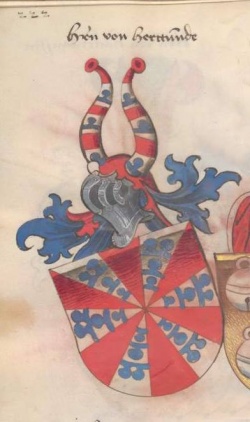 Gyronny of 12, gules and vair.
Gyronny of 12, gules and vair.
Modern source:[edit | edit source]
Pictorial Dictionary of SCA Heraldry (3rd edition):[edit | edit source]
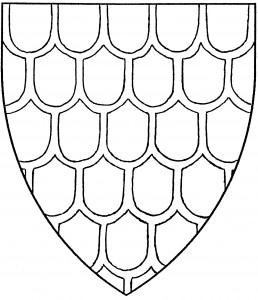
|
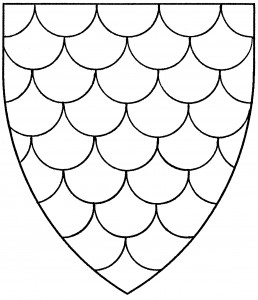
|
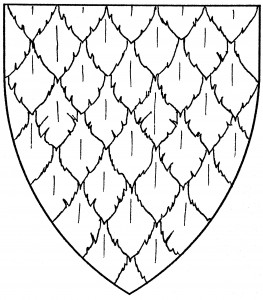
|
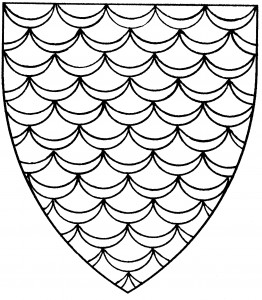
|
| Papellony (field treatment) (Period) | Papellony (fur) (Accepted) | Plumetty (Period) | Scaly (field treatment, not a fur) |
Images from Mistholme used by permission.
Vector Graphics:[edit | edit source]
- Book of Traceable Heraldic Art
- Viking Answer Lady - http://www.vikinganswerlady.com/Stars/Heraldry_SVG_Images/index.htm
- http://www.vikinganswerlady.com/Stars/Heraldry_SVG_Images/Ermine_Spots.htm (lots of wild ermine spots)
Pennsic Traceable Art Project:[edit | edit source]
A Heraldic Primer: Tinctures (based on old version)[edit | edit source]
http://heraldry.sca.org/primer/tinctures.html (defunct) The new version is here: http://heraldry.sca.org/armory/newprimer/h4f4.shtml
Furs There are several tinctures that are actually stylized patterns, classified as furs. These include:
Some Fur Variants[edit | edit source]
by Gotfrid von Schwaben at Modar University - http://www.modaruniversity.org/furs.gif
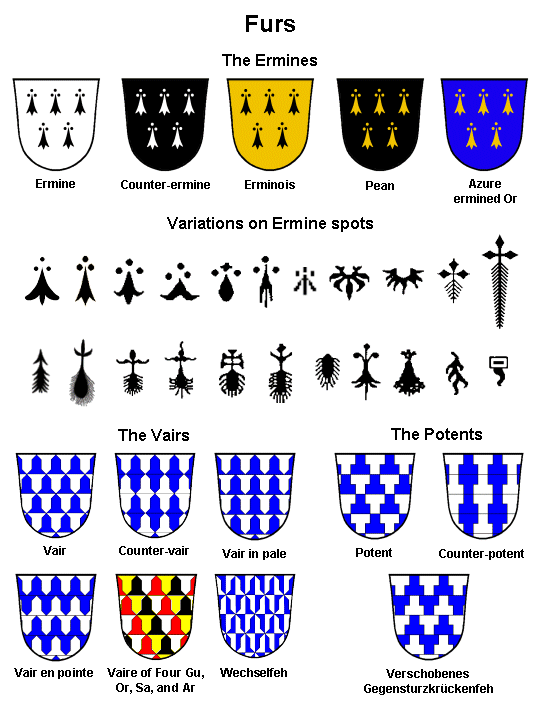
Sources:[edit | edit source]
- Academy of St. Gabriel "Medieval Heraldry Archive" - http://www.s-gabriel.org/heraldry/
- Archive of St. Gabriel reports - http://www.panix.com/~gabriel/public-bin/archive.cgi
- Laurel Armory Articles - http://heraldry.sca.org/laurel/armory_articles.html
- New Heraldic Primer (Heraldry for Non-Heralds) - http://heraldry.sca.org/armory/newprimer/
- Pictorial Dictionary of Heraldry (PicDic), 3rd Edition - http://mistholme.com/pictorial-dictionary-of-heraldry
- Period Armorials
- Parker's Heraldry - http://karlwilcox.com/parker/
- Riestap's Armorial Général - //http:www.euraldic.com/lasu/bl/bl_a_aa.html
Precedents:[edit | edit source]
Precedents of the SCA College of Arms - http://heraldry.sca.org/laurel/precedents.html
Morsulus Heralds Website - http://www.morsulus.org/ (to search the LoARs and Precedents)
Use the above links to be sure any precedents listed below haven't been superseded by newer precedents.
Definition:[edit | edit source]
(includes defaults, proper tinctures, blazoning)
August 2005 - plumetty is a form of vair:[edit | edit source]
Given Woodward's suggestion that the plumetty field is a form of vair; and given the wide variation in the depiction of vair in period, along with the fact that the internal markings of plumetty are worth no more than diapering we unfortunately must conclude that vair and plumetty are too similar for a CD. They lack the significant change in field partition required by RfS X.4.a for a CD. [Ilona von Neunhoff, 08/05, R-Atenveldt]
August 2002 - scaly vs papellony[edit | edit source]
[a sinister gore papellony Or and purpure] The gore was originally blazoned as scaly. Scaly is defined in the Pictorial Dictionary as "a field treatment, consisting of many semi-circles or lunes, covering the field." The overall effect of scaly is of thick lines on a background, as in the field treatment masoned (but with the panes of a different shape than in masoned.) This gore is tinctured in a form of papellony, which is also defined in the Pictorial Dictionary. Papellony has two forms. One form looks much like scaly, functions as a field treatment, and is blazoned as [background tincture] papellony [treatment tincture]. The other form of papellony is a field division and is blazoned as papellony [tincture x] and [tincture y]. The second form is the form found in this submission. It is drawn using solid panes of alternating tinctures, as in the field lozengy, but with the panes shaped like solid scales, rather than like the lozenges in lozengy. See the Pictorial Dictionary for more discussion. [Ailionóra inghean uí Mhurchadha, 08/2002, A-Calontir]
September 1997 - vairy of 3 tinctures or more[edit | edit source]
[registering vairy of three tinctures] Gerard Leigh (a 16th century herald) mentions very rare occurrences of vairy of three or more tinctures. This particular form of vairy was listed in the examples of vair, described by Fox-Davies as "vairy of four tinctures". Papworth has Vairy Or, gules and azure., Sir. Roger Holthouse, from Glover's Ordinary. As a treatment found in both a period treatise and actual period armory we have no qualms about registering this. (Diego Miguel de Vega, 9/97 p. 10)
September 1993 - Vair: the continuing saga[edit | edit source]
It was announced in the cover letter of the July 93 LoAR that vair is vair, whether drawn in an earlier, undulating style or in a late-period, angular form; the difference is purely artistic, and shouldn't even merit mention in the blazon. This has raised a question from some commenters as to which varieties of vair we should blazon, and why.
- Well, there are certainly some varieties of vair we've never blazoned: vair en pal, for instance, is a valid period rendition of plain vair that acquired its own name only in the 19th Century. That example provides us with the key: we should recognize only those varieties of vair that period heralds recognized. That excludes, e.g., vair en pal, vair ancient, and the German Gespaltenesfeh. Other varietal forms, however, were making their appearance toward the end of period; they should be acceptable, both as motifs and in blazon.
- The first vair-variant seems to have been potent. Legh's Accidens of Armorie gives an illustration of a potent field, which he blazons meirre or varry cuppe, and attributes to the Spanish; Guillim's Display of Heraldrie follows Legh in this, but prefers the blazon potent counter-potent. Both the fur and the blazon are acceptable, then; and indeed, Guillim's illustration shows a field potent en point, which might give us some justification for the same arrangement applied to vair.
- Vair en point makes an appearance in its own right, however, along with counter-vair. Both of these appear to be German variants; Leonhard's Grosse Buch der Wappenkunst blazons them as Wechselfeh "back-and-forth vair" and Sturzgegenfeh "falling-reversed vair", respectively. They first showed up in the early 17th Century, and managed to find actual use in French armory soon afterward: Baron's l'Art Heraldique cites the arms of Brotin, Contrevairé d'or et de gueules, and of Durant, Vair en pointe. We can consider them to have been used, and recognized by heralds, within our "grey area" of documentation -- if not explicitly from within period, then at the very least compatible with Society practice.
- It is equally illuminating to observe the styles of vair that period heralds did not distinguish. Foster's Dictionary of Heraldry shows many artistic variations taken from period rolls: they range from the wavy "vair ancient" style to the tesselated "modern vair" -- with a broad spectrum in between. See the arms of Bruis, p.33, and of Marmion, p.137, for different artists' versions of the same armory: the stylizations of vair include one that resembles nipples, and another that could be reblazoned barry embattled. Sometimes, the same roll of arms will employ two different styles of vair: Siebmacher's Wappenbuch of 1605, for instance, gives examples of "modern vair" (in the arms of von Pappenheim, p.19) and "vair ancient" (in the arms of von Linsingen, p.182). A similar example, with several different styles of vair ("ancient", "modern", and "other") used in a single roll of arms c.1500, may be seen in Pastoreau's Traité d'Héraldique, p.293.
- Some commenters have argued that the distinction between vair ancient and the more angular modern vair, though certainly worth no heraldic difference, should nonetheless be blazoned as a courtesy to the submitters -- just as we blazon shamrock vs. trefoil, or sword vs. scimitar. The latter terms, however, are all found in period; vair ancient is not, to the best of my knowledge (not even to the extent of being described in an heraldic tract as "vair as it was drawn in ancient times"). Given the absence of "vair ancient" from period blazons, given the equally varied styles of vair that weren't blazoned, and given the absurdity of a medievalist re-creation group having to specify "drawn in the medieval style" in a blazon (as silly as blazoning a lion drawn in the medieval style, not the modern naturalistic style), I find the tone of moral indignation in some of the recent commentary to be unjustified. Vair ancient should not be explicitly blazoned in the SCA if it was not so blazoned in period; it is exactly the sort of artistic detail that should be left to the artist.
http://heraldry.sca.org/loar/1993/09/cvr.html
March 1981 - papelonny diapering vs fur[edit | edit source]
Papelonny of one tincture is a form of diapering. Papelonny of two tinctures is an allowed fur. WVS [38] [LoAR 10 Mar 81], p. 9.
November 1978 - plumetty a form of vair[edit | edit source]
The article on heraldry in the 11th edition of the Encyclopedia Britannica, by Oswald Barron, states that there is a single British example of "Plumetty." ... A fifteenth-century book of arms gives it, blazoned "Plumetty of gold and purple," for Mydlam in Coverdale ... This form is acceptable for S.C.A. use. It should be treated as a form of vair, being composed of any metal with any color, but not two metals or two colors. Whichever tincture falls in the uppermost row should be mentioned first; blazoned in the standard form, Mydlam is "Plummetty or and purpure." (KFW, 15 Now 78 [22], p. 1)
Registerability:[edit | edit source]
(Restricted, Reserved, SFPP, OOP)
April 1994 - unregisterable form of plumetty[edit | edit source]
[Returning Plumetty argent and vert, a sledgehammer and overall a single horned anvil reversed sable.] The plumetty field treatment here [the pieces being long, vertical shafts with the tips in chief and curled over; similar to an illustration in Friar's A Dictionary of Heraldry, p.159] does not appear to be a valid period variant. [4/94, p.19]
Conflict:[edit | edit source]
August 2005 - vair vs plumetty no CD[edit | edit source]
Given Woodward's suggestion that the plumetty field is a form of vair; and given the wide variation in the depiction of vair in period, along with the fact that the internal markings of plumetty are worth no more than diapering we unfortunately must conclude that vair and plumetty are too similar for a CD. They lack the significant change in field partition required by RfS X.4.a for a CD. [Ilona von Neunhoff, 08/05, R-Atenveldt]
Identifiability:[edit | edit source]
Collected Precedents:[edit | edit source]
Collected Precedents:[edit | edit source]
- 2nd Tenure of Elisabeth de Rossignol (April 2011 - August 2011) - Collected Armory Precedents
- 1st Tenure of Elisabeth de Rossignol (May 2005 - July 2008) - FUR
- 2nd Tenure of François la Flamme (October 2004 - May 2005) - FUR
- The Tenure of Shauna of Carrick Point (May 2004 - August 2004) - Collected Armory Precedents
- 1st Tenure of François la Flamme (August 2001 - April 2004) - Collected Armory Precedents
- The Tenure of Elsbeth Anne Roth (June 1999 - July 2001) - Collected Armory Precedents
- The Tenure of Jaelle of Armida (June 1996 - June 1999) - Single HTML Document
- 2nd Tenure of Da'ud ibn Auda (November 1993 - June 1996) -
- The Tenure of Bruce Draconarius of Mistholme (June 1992 - October 1993) - Collected precedents
- 1st Tenure of Da'ud ibn Auda (June 1990 - June 1992) -
- The Tenure of Alisoun MacCoul of Elphane (September 1986 - June 1990) - Collected Precedents
- The Tenure of Baldwin of Erebor (August 1984 - August 1986) - Single HTML Document
- The Tenure of Wilhelm von Schlüssel (August 1979 - August 1984) - ALTERNATE VAIR
- The Tenure of Karina of the Far West (December 1975 - June 1979) - Collected Precedents
- The Early Days (June 1971 - June 1975) - Collected Precedents
WARNING: Do not cite this page as a reference. This page is on this wiki to make the content "searchable" and easier to find. If you find the information you seek here, go to the original sources (generally linked) to verify the information and use them for your documentation. Contact the editor-in-chief, Sofya la Rus, if there are copyright concerns or other issues. sofya at calontiri dot info
